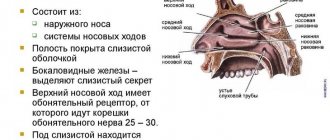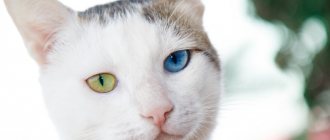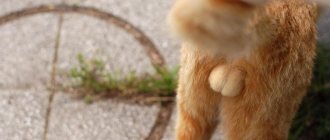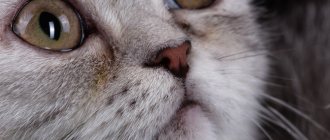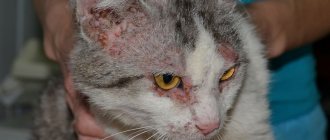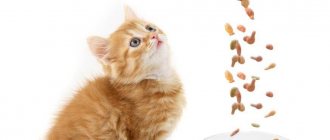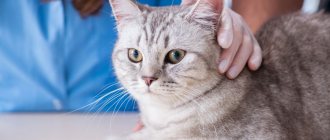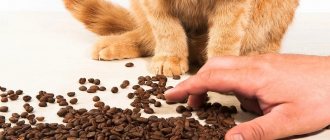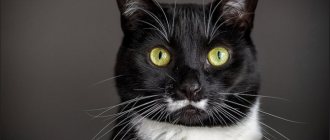What kind of nose does a healthy cat have?
- What kind of nose does a healthy cat have? The nose of a pet that is absolutely healthy is always warm and slightly moist. Such signs are considered completely normal. But there are certain points that you should be aware of.
- Many cat breeds, for example, the Bengal cat , have a constantly dry nose. This is inherent in their nature. It is a dry nose that indicates that the animal is absolutely healthy.
- The Persian cat's nose, on the contrary, is always quite wet. This is because this breed has a slightly flattened muzzle and after the cat finishes washing itself, its nose remains wet.
- The humidity of the nose is often influenced by what exactly the pet eats. Many people claim that cats that eat only dry food have a moister nose than cats that eat natural food. This is because when eating dry food, animals need a large volume of water, and therefore they regularly wet their nose, when they drink water, they lick their lips.
Healthy nose
- A healthy cat, who is constantly active, has a normal psychological state, his nose is not very hot, almost the same as the whole body. It is moisturized, always has the same color, the skin around the nose is elastic and has a uniform structure.
- A cat's nose may be dry and warm according to your opinion, according to your personal feelings. The fact is that the temperature of cats is a couple of degrees higher than that of humans. A wet nose may always seem cold to you, and a dry nose may always seem hot.
What signs will help determine the onset of the disease?
In addition to the signs listed above, the kitten also exhibits other symptoms indicating the onset of the disease. These include:
- increasing or decreasing the number of trips to the toilet; diarrhea or bloody stools; vomit; increased anxiety of the animal; hair loss; increased thirst; cardiopalmus; deep breathing; nasal discharge.
If you have these symptoms, you should consult a specialist; only he can make a correct diagnosis and prescribe treatment. You should not self-medicate, as this will only worsen the situation.
Often a kitten's dry nose is an indicator of intestinal problems, namely the presence of hair in the gastrointestinal tract. This is the only indicator of this problem.
Why does my cat have a warm and dry nose?
Cats spend a lot of time awake. They eat, walk, clean their fur and paws, while their nose remains moist.
There are only two reasons why this happens:
- The cat wets its nose with saliva when it licks itself and washes itself.
- The cat secretes nasal glands. They help the animal to catch the odors of the environment and eliminate excess heat.
Normal condition – a healthy pet’s nose is not wet. It's just a little damp, cold, smooth. There are no crusts, purulent or bloody discharge on the nose.
If a cat has clear discharge, this is also not considered a dangerous sign. But your nose cannot be regularly wet.
Dry
There are several main reasons why a cat has a warm and dry nose:
- During sleep , a cat's nose is usually dry. After all, the pet does not lick itself, and therefore saliva does not reach the olfactory organ, and the secretions of glandular cells do not protrude. The nose remains dry and warm for 30-60 minutes until the animal awakens.
- The cat may be near a heat source , for example, it could be a fireplace, a radiator, or a heater. Here everything is very clear - the nose becomes dry due to the device that people connected in order to increase the temperature in the room.
- Mild, non-prolonged discomfort. The disease can be minor, for example, the cat overate, ate hair when it was licked and it got into the stomach. If your cat is a little unwell, then her nose sometimes becomes dry.
- Active movements, games. Due to rapid movement, your pet's body temperature may become higher. Consequently, the nose dries out and becomes warmer.
- In small kittens, thermoregulation has not yet fully adjusted. In addition, the temperature in small animals is usually higher than in adults. This is why an animal's nose sometimes becomes dry, regardless of the time of day.
- If it is hot enough in the house or outside and stuffy, the pet’s nose quickly dries out. And it begins to moisturize after the cat finds itself in normal conditions.
- Stressful state. A cat's nose is dry and warm due to severe fright, during pregnancy, childbirth, and so on.
- Professional cat breeders claim that wet noses in old cats are a rare phenomenon. This happens because over time, the pet’s metabolism may slow down, and the cat itself becomes less active. As in all of these cases, this phenomenon, as a rule, is not considered a pathology.
Why is it dry and warm
? So, we were able to find out why a cat’s nose becomes dry. But he can remain in this state for only a short time. Now let's find out when to worry if your animal's nose has been dry for a very long time.
A cat has a dry and warm nose: when is this a sign of illness?
Sometimes a cat has a dry and warm nose - this is a harbinger of a serious illness. Sometimes the illness turns out to be very serious. The nose becomes dry in the following cases:
- Gastrointestinal disorders. A cat can be poisoned by stale, bad food, this can happen after taking antibiotics. In this case, the cat’s nose becomes dry, its body temperature increases, and the cat may be accompanied by vomiting, loose stools, and weakness. The pet may refuse food altogether.
- Infectious, viral, bacterial disease. In addition to the fact that your pet's nose may become dry, his body temperature may increase, he may be bothered by a fever, and have loose stools. The cat may sneeze, refuse food or water.
- Diseases caused by ticks . The cat often begins to scratch his ears and muzzle, shake his head, behave restlessly, and refuse to eat. In this case, as a rule, the animal’s skin becomes inflamed, thickens, the skin in the head area becomes bald, its temperature rises, and its nose becomes dry.
- Cold - the cat's ears become hot, his nose becomes dry and cool. Body temperature increases, the animal weakens.
Maybe due to workload
- Note that a dry spout almost always has the same temperature - minimum +39.5°C and maximum +40°C. What can cause hyperthermia? There can be quite a few reasons: the presence of cancer, failures in the functionality of certain organs.
- The nose may become dry if the cat has worms, which poison the animal's body. In addition, there are cases when a cat suddenly develops a fever, but he still feels healthy.
- To help you understand whether your cat is sick or completely healthy, check his nose for moisture. Be sure to pay attention to what temperature your pet’s nose is and what condition it is in. Is the cat bothered by vomiting, diarrhea, does the animal refuse to eat, does it have discharge from its eyes, nose, and so on. If your animal’s nose is constantly dry, or other alarming symptoms arise, then immediately take your pet to the veterinary clinic.
- If your pet's nose is even hot (you feel this at the first touch), and the animal itself looks weak, this is very serious. The kitten's temperature may rise significantly. Don't wait, take your pet to the doctor immediately.
Disease
A similar thing occurs in domestic animals during a viral infection. And such diseases, as a rule, can be dangerous and lead to death. To avoid this, you should do the following:
- Place the cat in a room that is well ventilated. Just make sure there are no drafts. The ideal room temperature in this case is +20°C.
- Give your pet plenty of water. You can add a little sugar to it.
- Call your veterinarian.
In what cases should you immediately contact the clinic?
Here are the cases in which you need to immediately contact the clinic:
- The animal is apathetic and does not react to anything.
- The kitten refuses food and water (refusing to drink is the worst).
- The baby is very chilly and has a lot of snot.
- Severe cough and other accompanying signs of infectious diseases of the upper respiratory tract.
- When breathing is accompanied by strong, heavy wheezing.
- Sunken eyeballs, a cold nose and limbs, as well as sagging skin are signs of fatal dehydration; you need to take your kitten to the doctor immediately!
The cat has a cold and dry nose: what to do?
When a cat's nose is cold and dry, this is also a bad sign. This may happen for the following reasons:
- The cat has severe intoxication, regardless of its origin.
- During sepsis.
- If your pet is experiencing the thermal stage of some infectious disease.
- During intermittent fever. In this case, the animal’s temperature can periodically rise and then decrease.
- In each case, the nose becomes cold, as does the body of the animal. Most often, an unexpected drop in body temperature indicates that the animal’s brain does not have time to respond to thermoregulation.
Cold
- Sometimes this condition leads to the death of the pet. Immediately place the cat in a warm room (just make sure the room is not too hot), and call a veterinarian immediately. Self-treatment in such a situation can lead to big problems.
Action plan
If you find a dry nose in your cat, then the first thing you need to do is be patient and watch it for a day or two.
In this case, you will have the most complete picture possible, both about his behavior and regarding other possible symptoms.
If even with a dry nose, the cat’s general behavior does not change - he is very active, sleeps enough, eats well, then most likely you can dispel your worries about this.
But you must understand that even in a situation where you find a dry nose, which has begun to crack, you should not try to smear it with anything.
Getting rid of the causes of such a problem will in itself begin to return everything to normal - the cracks will heal, and the cat will lick its nose and restore the required level of humidity.
Ringworm in cats - main signs, symptoms, prevention and treatment of ringworm in cats (105 photos)Pancreatitis in cats: first symptoms, nutritional nuances and treatment options (125 photos and videos)
Subcutaneous mites in cats - first symptoms, treatment options and real photos of examples of parasite damage (110 photos + video)
The cat has a dry and warm nose: what to do at home?
If your cat feels fine and nothing serious has happened to him, you can help your pet yourself. We offer you special measures that will be useful to you if your cat has a dry and warm nose.
- The cat's nose is dry and dirty. If you don’t clean your cat’s nose, it can become dirty, after which it will be difficult for the pet to breathe and the physiological lubrication of the nose will decrease. As a result, thermoregulation will be disrupted and the nose will be hot.
- Carefully clean the dirty spout from the outside and inside. Be careful not to damage sensitive tissue. After approximately 20 min. you will notice that your cat's condition returns to normal.
- Burn from strong sun rays. Every cat loves to sleep in the sun. But prolonged sleep under strong rays of the sun does not bring any benefit. Situations with burns are much more common than expected. This is especially true for those individuals who have a delicate pink nose.
- In a cat that has received a sunburn, the nose becomes red, hot, and the pet feels pain at the slightest touch. Over time, the skin on the nose becomes rougher, it becomes dry and rough. In this case, treat the cat’s nose with an anti-burn drug that has moisturizing and anti-inflammatory properties. Apply the product carefully so that it does not penetrate the nostrils. Repeat the procedure again until the nose looks normal.
Treat your nose
- Allergic reaction to chemicals. Many pets can have allergies. Don't forget about this when cleaning the house. If you do not wash the product well, it can cause great harm to the cat, who likes to poke his own nose into every corner.
- Urgently carry out another wet cleaning. Wash all surfaces thoroughly with clean water. Wash away any remaining chemicals that may cause irritation or allergies in your cat. Also does not include consultation with a veterinarian. He will tell you which antihistamine can be given to your pet and in what dose.
Pathological causes that can be dealt with at home
Excessive carelessness is much more dangerous than excessive vigilance, so it is better to once again seek help from veterinarians than to miss a serious pathology. But in some cases, the problem can be solved at home; it is only important to correctly determine the cause of the deviation. To do this, you need to pay close attention to the accompanying symptoms.
Sunburn
An increase in the temperature of the lobe is an absolutely normal consequence of an animal walking under the scorching sun. But if the cat's nose becomes not just hot, but also red and flaky, then it is likely that it is a sunburn. Animals with pink noses are especially sensitive to sunlight.
To eliminate the burn, you can use natural vegetable oil. If your pet reacts too aggressively to touching its face, you can apply Vaseline or Panthenol to its nose (in this case you will have to hold the pet’s mouth for 5-6 minutes). But if the problem recurs again and again, you will still have to contact a veterinarian. Otherwise, skin cancer may develop.
Contact allergy
A cat's hot nose may be a sign of a mild allergic reaction. Associated symptoms:
- a sharp change in the pigmentation of the lobe (redness);
- sneezing;
- the appearance of a rash on the face.
This type of allergy usually occurs when unprotected nasal tissue comes into direct contact with chemicals and dyes. But cats especially often react negatively to dishes made of low-quality plastic.
First of all, you need to exclude your pet from contact with a potential allergen; Replace all plastic utensils with ceramic or glass ones. Apply a cool compress to the face, and if the symptoms are too painful, then Suprastin can be used.
The kitten has a dry and warm nose: what to do?
- The body of a small kitten is very similar to that of a child. He also has a high metabolism. A pet's nose can react to various changes much faster than that of an adult cat.
- And thermoregulation at a young age is still unstable; it has not yet fully formed.
- During the course of a day, your kitten’s nose may become cold, then hot, dry, or wet several times.
This may depend on all sorts of factors:
- The kitten just woke up.
- The pet started playing.
- The baby has recently eaten.
In a kitten
The condition of the nose may also depend on what mood the kitten is in.
- Such changes are considered natural, so you should not worry about such an event. But, if the animal shows alarming signs (the mood, behavior has changed, the kitten has become less active), it is necessary to sound the alarm.
- Kittens have dry and warm noses unless their mother licks them thoroughly. The kids themselves cannot do this on their own. In such a situation, help the growing animal. Wipe the kitten's face with warm water several times a day, but it must be boiled.
- The condition of a small kitten's nose can tell you a lot. But his risk of getting sick is much greater if you have not yet had time to vaccinate him. In addition, a dry, hot nose may indicate that the pet has been poisoned. In this case, go to the vet immediately.
Watch the nose
Try to pay close attention to such physiological changes in cats. As a rule, they do not signal any serious illness. But there are cases that a dry nose is only the first symptom of a serious illness, and therefore you cannot do without the help of a veterinarian.
Causes
When illness occurs, your pet's nose may become dry, hot, or excessively wet.
An increase in humidity, the presence of mucus, crusts, peeling, and blood means the presence of the following problems:
- Penetration of a bacterial or fungal infection into the body.
- Entry of foreign objects into the respiratory tract.
- Allergic reaction.
- Injuries.
- Tumors.
- Diseases of the oral cavity.
You should consult a doctor if your animal exhibits the following symptoms along with the problems that have arisen:
- high body temperature;
- lethargy and passivity;
- hot ears.
- vomit;
- crusts under the nose;
- peeling of the skin;
- blood, pus;
- difficulty breathing, wheezing;
- refusal to eat;
- change in nose color.
